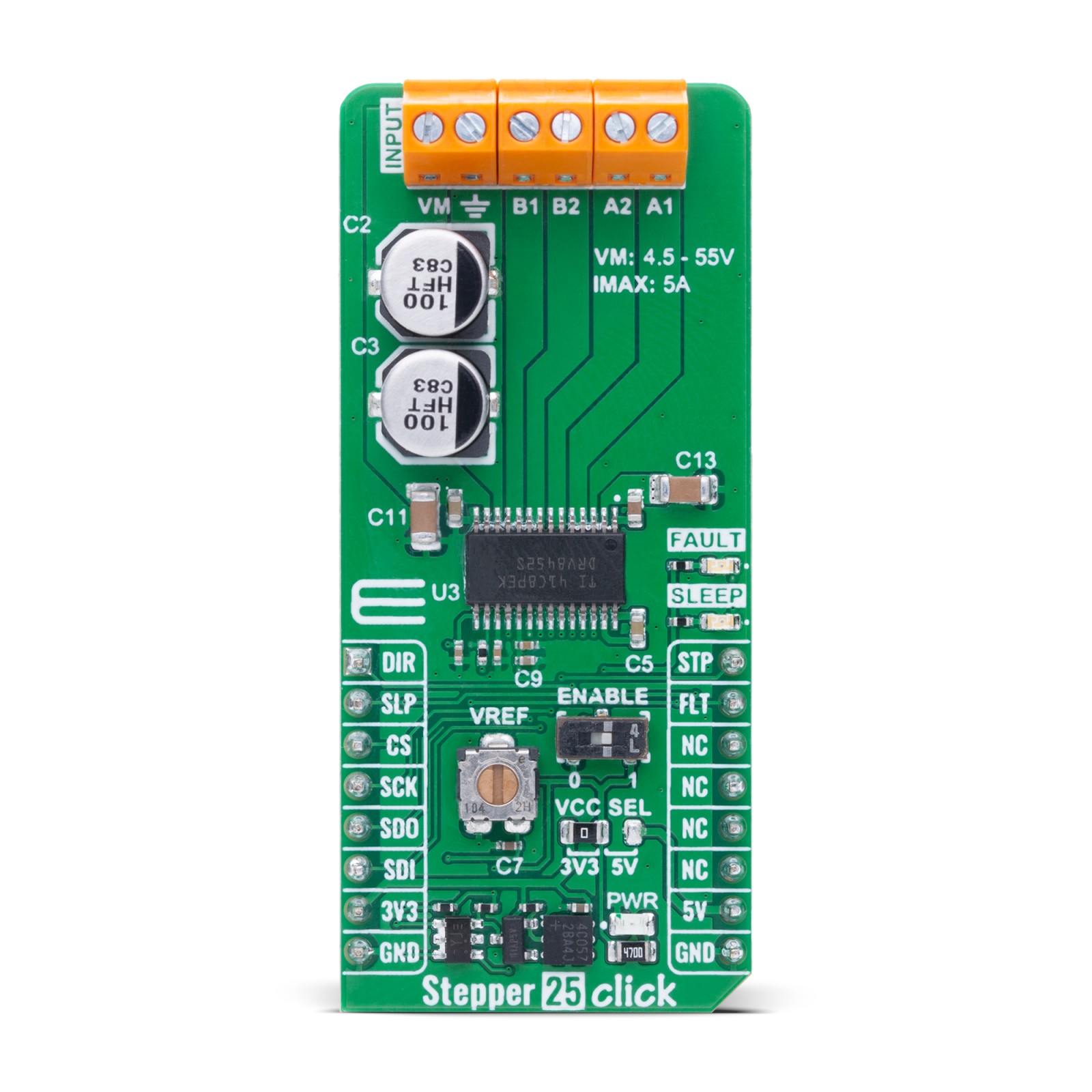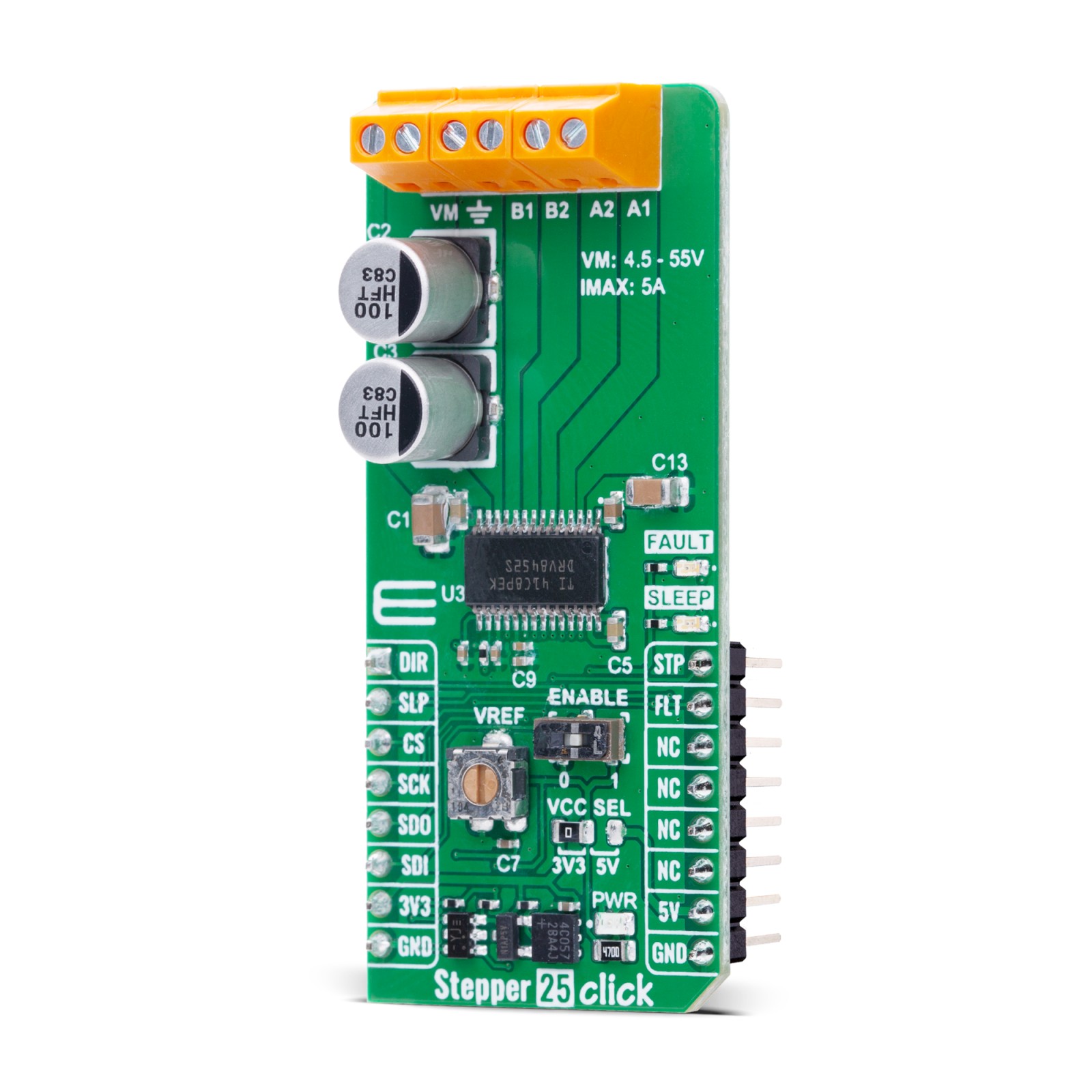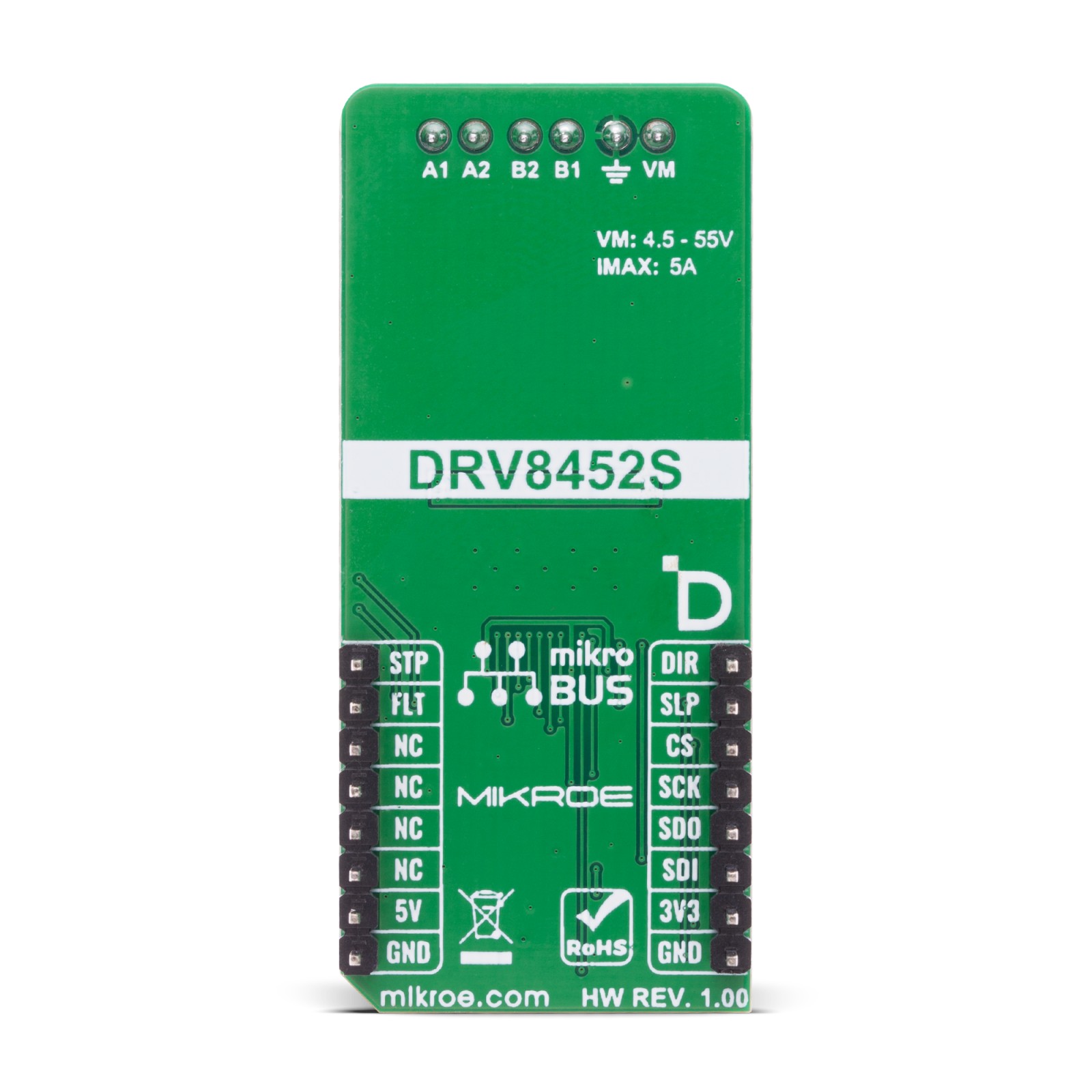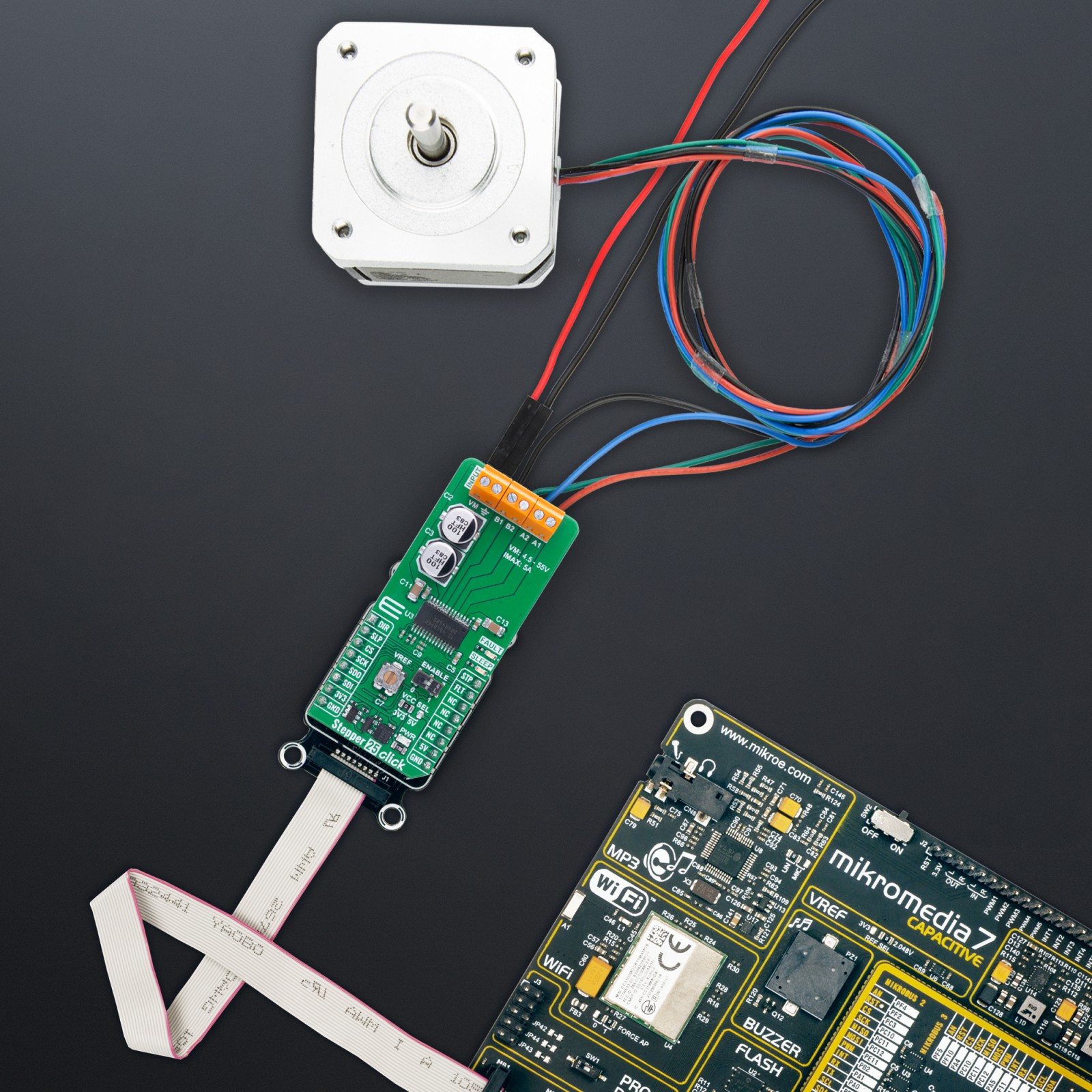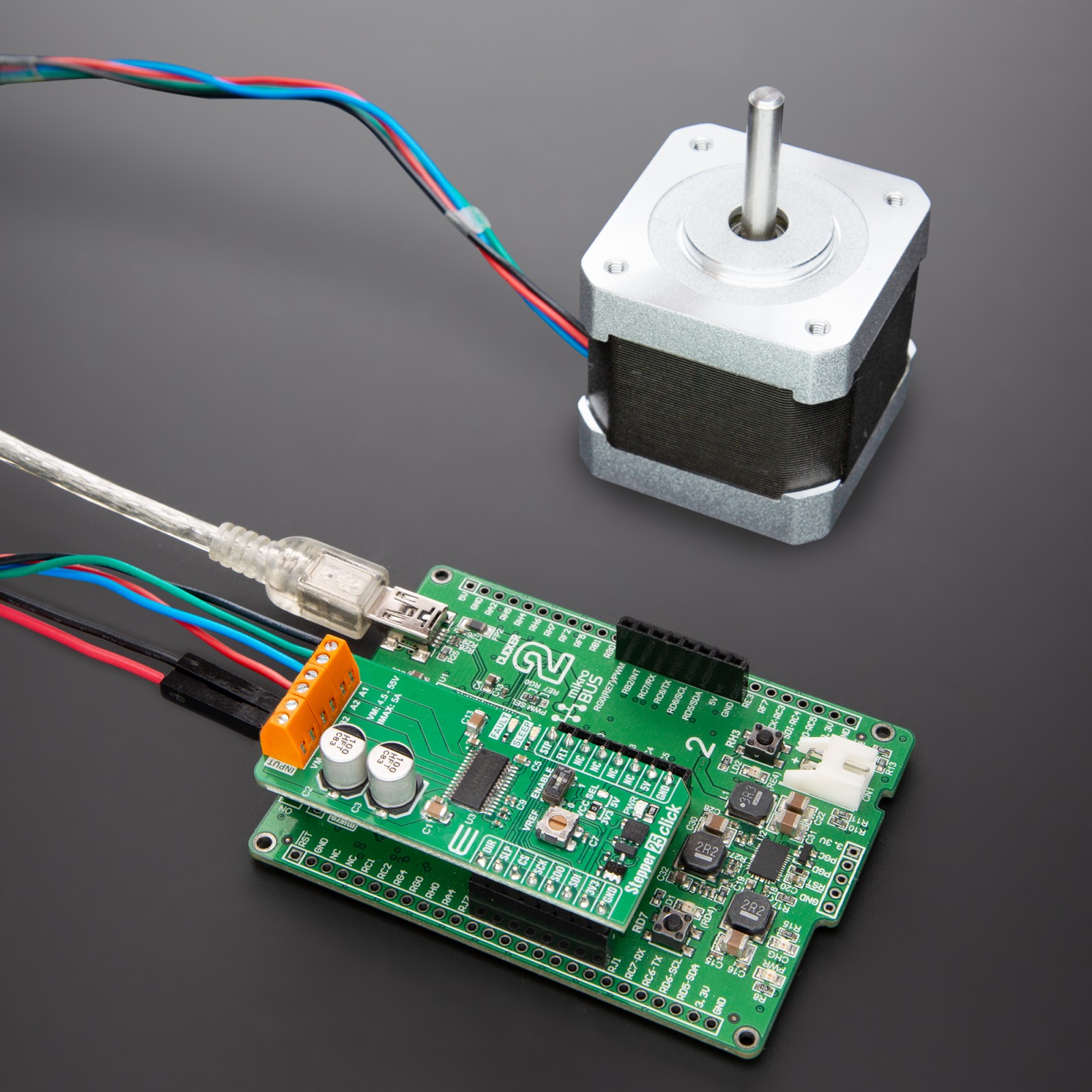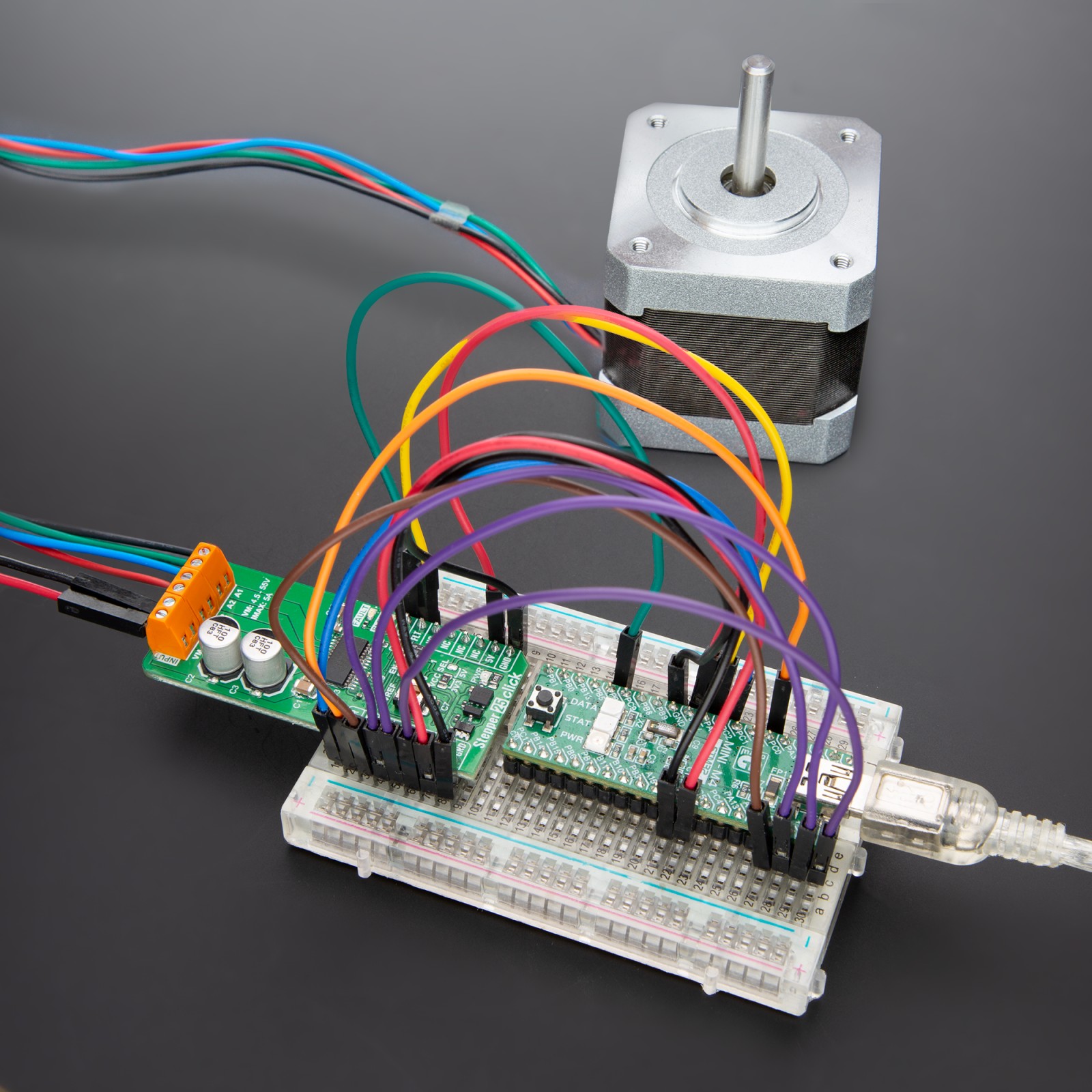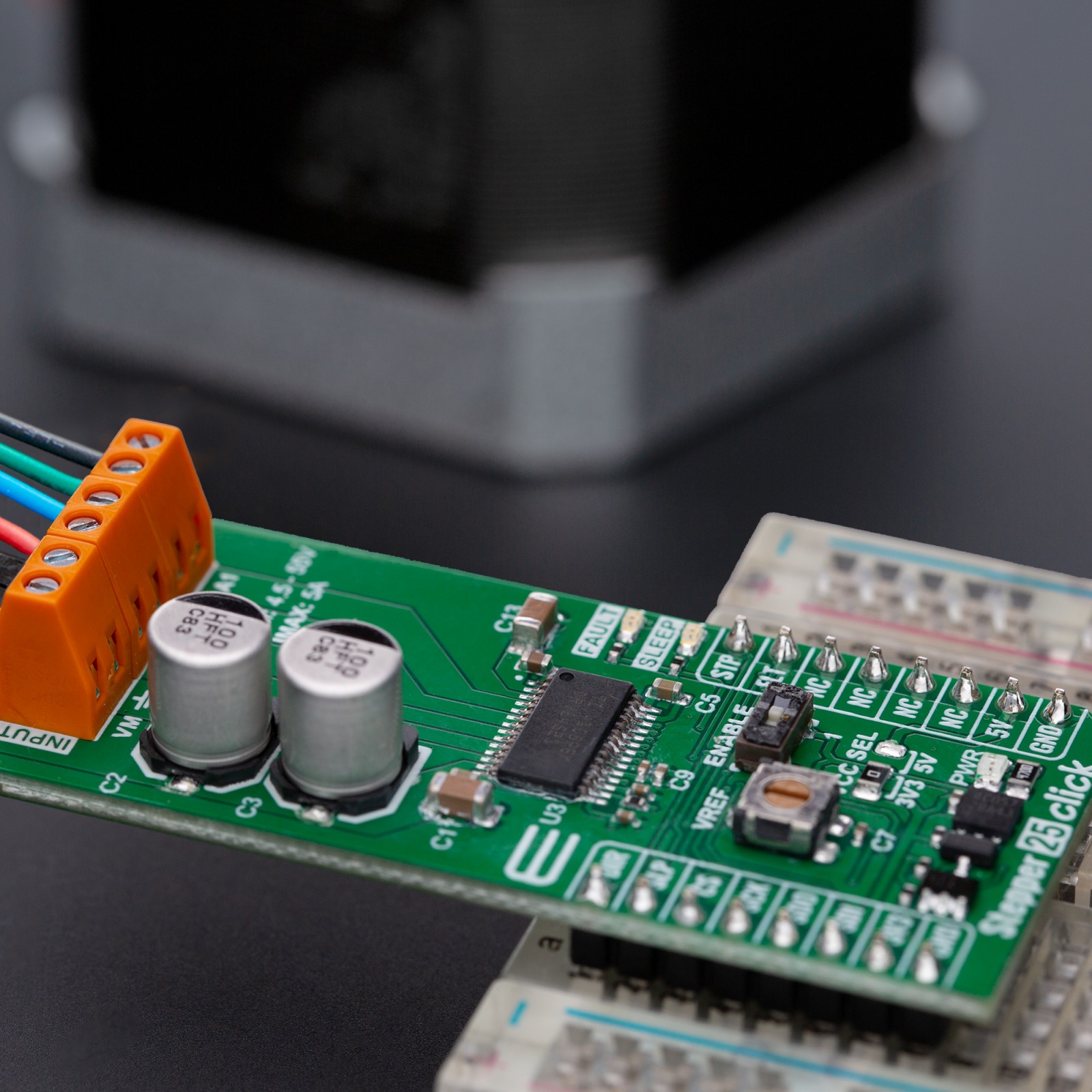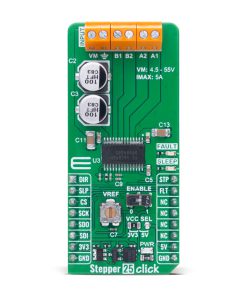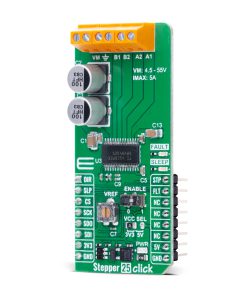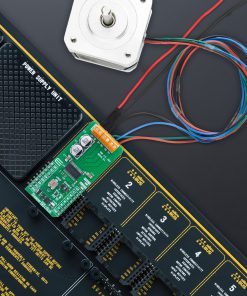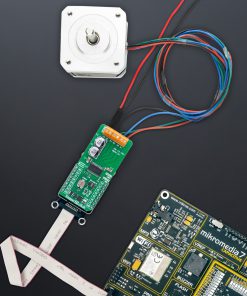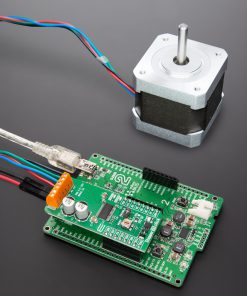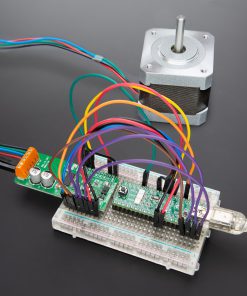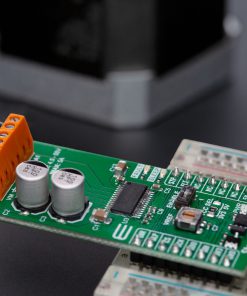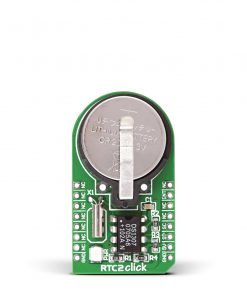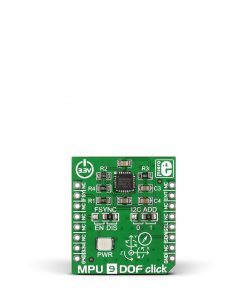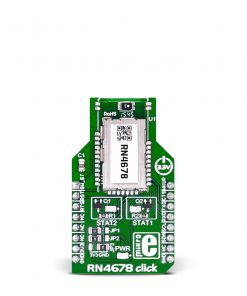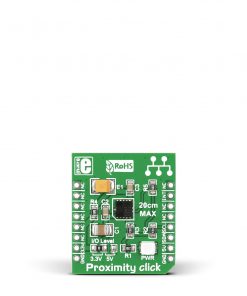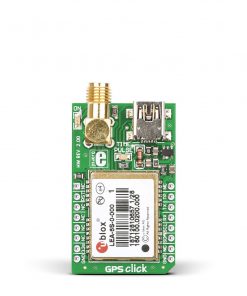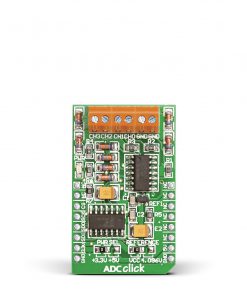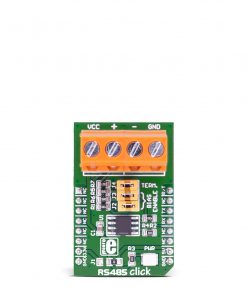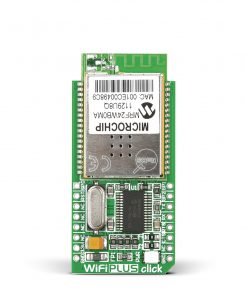Subtotal: R1,355.00
Stepper 25 Click
R660.00 ex. VAT
Stepper 25 Click is a compact add-on board designed for precise control of bipolar stepper motors. This board features the DRV8452, a high-power stepper motor driver from Texas Instruments, known for its high performance and integration. The board supports a wide supply voltage range from 4.5V to 55V and delivers up to 5A full-scale or 3.5A RMS output current. It features advanced microstepping down to 1/256, auto-torque adjustment for improved efficiency, stall detection, smart tune decay modes, and integrated current sensing. Stepper 25 Click is ideal for applications such as textile machines, factory automation, robotics, diagnostic equipment, multifunction printers, and industrial control systems.
Stepper 25 Click is fully compatible with the mikroBUS™ socket and can be used on any host system supporting the mikroBUS™ standard. It comes with the mikroSDK open-source libraries, offering unparalleled flexibility for evaluation and customization. What sets this Click board™ apart is the groundbreaking ClickID feature, enabling your host system to seamlessly and automatically detect and identify this add-on board.
Stock: Lead-time applicable.
| 5+ | R627.00 |
| 10+ | R594.00 |
| 15+ | R561.00 |
| 20+ | R539.88 |
How does it work?
Stepper 25 Click is based on the DRV8452 motor driver IC from Texas Instruments for precise control of bipolar stepper motors. The DRV8452 includes two N-channel power MOSFET H-bridges, current sense resistors, an advanced current regulation system, and a microstepping indexer, all within a single package. This robust integration enables the board to handle a wide supply voltage range from 4.5V to 55V, while delivering an impressive output current of up to 5A full-scale, or 3.5A RMS, ensuring stable performance in high-power scenarios. Thanks to the capabilities of the DRV8452, Stepper 25 Click is ideally suited for a wide range of applications including textile and sewing machines, factory automation systems, robotic platforms, diagnostic equipment, multifunction printers, as well as PLC, DCS, and PAC-based systems. This makes it a versatile and reliable choice for engineers and developers working on complex motion control tasks that demand both power and precision.

One of the standout features of the DRV8452 is the auto-torque function, which dynamically adjusts the output current based on the motor load. This not only enhances the overall efficiency of the system but also significantly reduces power losses during operation. Fine-tuning of the motor current is made simple through the onboard VREF trimmer, allowing for precise adjustments to match specific load requirements. Additionally, the board includes an ENABLE switch that allows users to control the activation of the output channels – when set to position 0, all outputs are disabled, and when set to position 1, the outputs are enabled and ready for operation.
Stepper 25 Click uses a standard 4-wire SPI interface for communication with the host MCU, allowing precise configuration of the DRV8452 and optimization of the auto-torque algorithm for various motor applications. It features stall detection to notify the system when the motor is blocked or reaches its travel limit, ensuring safe operation. To reduce energy usage, the standstill power saving mode minimizes power loss when the motor is holding position. The DRV8452 also includes an integrated current-sense architecture that eliminates the need for external sense resistors by using a current mirror and internal MOSFETs.
A combination of STP and DIR pins allows a host MCU to manage the direction and step rate of the stepper motor. The integrated microstepping indexer of the DRV8452 enables precise motion control without requiring the host to manage winding currents. The indexer supports a wide range of resolutions, including full step, half step, and microsteps down to 1/256, ensuring exceptionally smooth and accurate motion. Higher microstepping levels significantly reduce audible noise and enhance movement fluidity. Additionally, the automatic microstepping mode interpolates low-frequency input signals into high-resolution steps, improving current regulation and further minimizing noise during operation.
To regulate the winding current effectively, the DRV8452 use various decay modes such as slow, mixed, and fast decay. The DRV8452 also features advanced smart tune decay modes that automatically adapt to ensure optimal current regulation, regardless of changes in supply voltage, motor speed, or aging. Smart tune Ripple Control employs a variable off-time ripple current scheme to reduce current distortion in the motor windings, while Smart tune Dynamic Decay uses a fixed off-time with dynamic fast decay percentages for improved performance. In addition to these, the DRV8452 includes a silent step decay mode designed to enable extremely quiet operation during standstill and low-speed motion.
Stepper 25 Click features two additional control pins: FLT and SLP. The FLT pin serves as a fault indicator, signaling any fault conditions such as overcurrent or thermal shutdown. The SLP pin controls the device’s power mode – setting it to logic HIGH enables normal operation, while logic LOW puts the device into a low-power sleep mode to conserve energy. Both pins are paired with red LED indicators labeled FAULT and SLEEP, providing clear visual feedback on the device’s fault status and power state for easier monitoring and debugging.
This Click board™ can operate with either 3.3V or 5V logic voltage levels selected via the VCC SEL jumper. This way, both 3.3V and 5V capable MCUs can use the communication lines properly. Also, this Click board™ comes equipped with a library containing easy-to-use functions and an example code that can be used as a reference for further development.
Specifications
Type
Stepper
Applications
Ideal for applications such as textile machines, factory automation, robotics, diagnostic equipment, multifunction printers, and industrial control systems
On-board modules
DRV8452 – high-power stepper motor driver from Texas Instruments
Key Features
Control of bipolar stepper motors, output current up to 5A full-scale or 3.5A RMS, SPI interface, auto-torque function, stall detection and reporting, standstill power saving mode, integrated current-sense architecture, advanced microstepping indexer supporting up to 1/256 microsteps, automatic microstepping mode, smart tune decay modes, direction and step control, and more
Interface
GPIO,SPI
Feature
ClickID
Compatibility
mikroBUS™
Click board size
L (57.15 x 25.4 mm)
Input Voltage
3.3V or 5V,External
Pinout diagram
This table shows how the pinout on Stepper 25 Click corresponds to the pinout on the mikroBUS™ socket (the latter shown in the two middle columns).
Onboard settings and indicators
| Label | Name | Default | Description |
|---|---|---|---|
| LD1 | PWR | – | Power LED Indicator |
| LD2 | FAULT | – | Fault LED Indicator |
| LD3 | SLEEP | – | Sleep Mode LED Indicator |
| JP1 | VCC SEL | Left | PowerVoltage Level Selection 3V3/5V: Left position 3V3, Right position 5V |
| SW1 | ENABLE | Right | Output Enable Switch |
| VR1 | VREF | – | Current Threshold Trimmer |
Stepper 25 Click electrical specifications
| Description | Min | Typ | Max | Unit |
|---|---|---|---|---|
| Supply Voltage | 3.3 | – | 5 | V |
| External Power Supply | 4.5 | – | 55 | V |
| Output Current | – | – | 5 | A |
Software Support
Stepper 25 Click demo application is developed using the NECTO Studio, ensuring compatibility with mikroSDK‘s open-source libraries and tools. Designed for plug-and-play implementation and testing, the demo is fully compatible with all development, starter, and mikromedia boards featuring a mikroBUS™ socket.
Example Description
This example demonstrates the operation of the Stepper 25 Click board, which is used to control a bipolar stepper motor. The application initializes the board and executes different step modes, directions, and speeds to showcase precise motor control.
Key Functions
stepper25_cfg_setupThis function initializes Click configuration structure to initial values.stepper25_initThis function initializes all necessary pins and peripherals used for this Click board.stepper25_default_cfgClick Default Configuration function.stepper25_set_directionThis function sets the motor direction by setting the DIR pin logic state.stepper25_set_step_modeThis function sets the step mode (microstepping level) of the Stepper 25 device.stepper25_drive_motorThis function drives the motor for the specific number of steps at the selected speed.
Application Init
Initializes the logger and Stepper 25 Click board. Configures the motor driver with default settings, preparing it for stepper motor control.
Application Task
Moves the stepper motor in different step modes and directions at varying speeds. The motor completes a predefined number of steps in each mode, switching between clockwise (CW) and counterclockwise (CCW) directions with different step resolutions.
Application Output
This Click board can be interfaced and monitored in two ways:
- Application Output – Use the “Application Output” window in Debug mode for real-time data monitoring. Set it up properly by following this tutorial.
- UART Terminal – Monitor data via the UART Terminal using a USB to UART converter. For detailed instructions, check out this tutorial.
Additional Notes and Information
The complete application code and a ready-to-use project are available through the NECTO Studio Package Manager for direct installation in the NECTO Studio. The application code can also be found on the MIKROE GitHub account.
Resources
Downloads
| Weight | 22 g |
|---|---|
| Brand | MikroElektronika |

 MiWi 2 Click
MiWi 2 Click 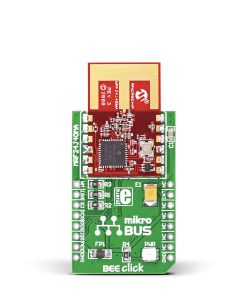 BEE Click
BEE Click 